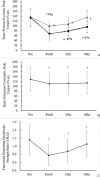Effects of preconditioning hamstring resistance exercises on repeated sprinting-induced muscle damage in female soccer players
- PMID: 30449945
- PMCID: PMC6224846
- DOI: 10.5114/biolsport.2018.77827
Effects of preconditioning hamstring resistance exercises on repeated sprinting-induced muscle damage in female soccer players
Abstract
To examine whether adding preconditioning hamstring resistance exercises to a regular warm-up prior to a repeated sprinting exercise provides protection against the sprinting-induced muscle damage. Ten female soccer players (mean ± SD age: 21.3 ± 4.5yrs; height: 171.34 ± 8.29 cm; weight: 68.53 ± 11.27 kg) participated in this study. After the familiarization visit, the subjects completed three separate randomly sequenced experimental visits, during which three different warm-up interventions were performed before the muscle-damaging protocol (12 sets of 30-m maximal repeated sprints): 1. Regular running and static stretching (Control); 2. Control with hyperextensions (HE); 3. Control with single leg Romanian deadlift (SLRD). Before (Pre), immediately (Post0), 24 hours (24hr), and 48 hours after (48hr) the sprints, hamstring muscle thickness, muscle stiffness, knee flexion eccentric peak torque, knee extension concentric peak torque, and functional hamstring to quadriceps ratios were measured. Repeated sprints have induced muscle damage (e.g., an average of 42% knee flexion eccentric strength reduction) in all three conditions. After the SLRD, hamstring muscle thickness decreased from 24hr to 48hr (p < 0.001). Additionally, muscle stiffness and eccentric strength for the SLRD showed no difference from baseline at 24hr and 48hr, respectively. When compared with the SLRD at 48hr, the muscle stiffness and the eccentric strength were greater and lower, respectively, in other protocols. The SLRD protocol had protective effect on sprinting-induced muscle damage markers than other protocols. Athletes whose competitions/training are densely scheduled may take advantage of this strategy to facilitate muscle recovery.
Keywords: Eccentric contraction; Muscle damage; Preconditioning; Resistance exercise; Warm-up.
Conflict of interest statement
The authors declare that they have no conflict of interest.
Figures


Similar articles
-
Differential Effects of Different Warm-up Protocols on Repeated Sprints-Induced Muscle Damage.J Strength Cond Res. 2018 Nov;32(11):3276-3284. doi: 10.1519/JSC.0000000000002310. J Strength Cond Res. 2018. PMID: 29084097
-
Effects of hamstring-emphasized neuromuscular training on strength and sprinting mechanics in football players.Scand J Med Sci Sports. 2015 Dec;25(6):e621-9. doi: 10.1111/sms.12388. Epub 2014 Dec 30. Scand J Med Sci Sports. 2015. PMID: 25556888 Clinical Trial.
-
Hamstrings strength imbalance in professional football (soccer) players in Australia.J Strength Cond Res. 2015 Apr;29(4):997-1002. doi: 10.1519/JSC.0000000000000747. J Strength Cond Res. 2015. PMID: 25426513
-
Acute effects of static stretching on peak and end-range hamstring-to-quadriceps functional ratios.World J Orthop. 2015 Oct 18;6(9):719-26. doi: 10.5312/wjo.v6.i9.719. eCollection 2015 Oct 18. World J Orthop. 2015. PMID: 26495249 Free PMC article.
-
The effects of multidirectional soccer-specific fatigue on markers of hamstring injury risk.J Sci Med Sport. 2010 Jan;13(1):120-5. doi: 10.1016/j.jsams.2008.08.005. Epub 2008 Oct 30. J Sci Med Sport. 2010. PMID: 18976956
Cited by
-
The Effects of Plyometric Conditioning on Post-Activation Bench Press Performance.J Hum Kinet. 2020 Aug 31;74:99-108. doi: 10.2478/hukin-2020-0017. eCollection 2020 Aug. J Hum Kinet. 2020. PMID: 33312279 Free PMC article.
-
Influence of the Strap Rewind Height During a Conical Pulley Exercise.J Hum Kinet. 2020 Aug 31;74:109-118. doi: 10.2478/hukin-2020-0018. eCollection 2020 Aug. J Hum Kinet. 2020. PMID: 33312280 Free PMC article.
-
The Effect of Single Leg Romanian Deadlift on the Risk of Hamstring Strain Injuries in Track and Field Athletes: A Cohort Study.Int J Sports Phys Ther. 2025 May 2;20(5):657-665. doi: 10.26603/001c.136803. eCollection 2025. Int J Sports Phys Ther. 2025. PMID: 40322523 Free PMC article.
-
Day-to-day Variation of The Heart Rate, Heart Rate Variability, and Energy Expenditure During FIFA 11+ and Dynamic Warm-up Exercises.J Hum Kinet. 2022 Feb 10;81:73-84. doi: 10.2478/hukin-2022-0007. eCollection 2022 Jan. J Hum Kinet. 2022. PMID: 35291626 Free PMC article.
References
-
- Askling CM, Tengvar M, Saartok T, Thorstensson A. Acute first-time hamstring strains during high-speed running: a longitudinal study including clinical and magnetic resonance imaging findings. Am J Sports Med. 2007;35(2):197–206. - PubMed
-
- Jonhagen S, Nemeth G, Eriksson E. Hamstring injuries in sprinters. The role of concentric and eccentric hamstring muscle strength and flexibility. Am J Sports Med. 1994;22(2):262–6. - PubMed
-
- Johansson PH, Lindstrom L, Sundelin G, Lindstrom B. The effects of preexercise stretching on muscular soreness, tenderness and force loss following heavy eccentric exercise. Scand J Med Sci Sports. 1999;9(4):219–25. - PubMed
-
- Keane KM, Salicki R, Goodall S, Thomas K, Howatson G. Muscle Damage Response in Female Collegiate Athletes After Repeated Sprint Activity. J Strength Cond Res. 2015;29(10):2802–7. - PubMed
-
- Howatson G, Milak A. Exercise-induced muscle damage following a bout of sport specific repeated sprints. J Strength Cond Res. 2009;23(8):2419–24. - PubMed
LinkOut - more resources
Full Text Sources
